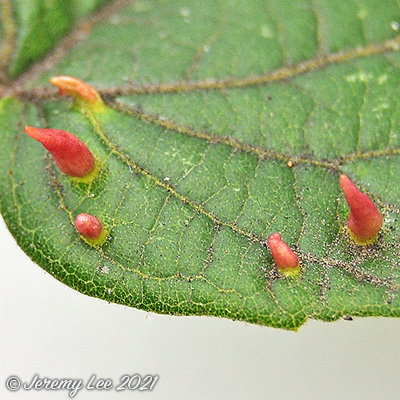
 |
|
Scientific Classifications explained » Amphibians » Ants » Aphids » Bees » Beetles » Birds » Bugs » Butterflies » Caterpillars » Damselflies » Dragonflies » Earwigs » Flies » Frog/Leafhoppers » Fungi » Galls » Grasshoppers » Harvestmen » Hoverflies » Lacewings » Ladybirds » Leaf Mines » Lichens » Mammals » Millipedes » Mosses » Moths » Sawflies » Slugs » Snails » Spiders » Trees & Shrubs » Wasps » Wild Flowers » Woodlice » Postboxes |
UK Nature > Galls > Lime Nail Gall

Gall causer: Eriophyes tiliae Common Name: Lime Nail-gall Mite Eriophyes tiliae is a mite that forms the Lime Nail Gall. It develops in a chemically induced gall; an erect, oblique or curved distortion rising up from the upper surface of the leaves of the common lime tree, Tilia × europaea. During late spring and summer, tubular growths up to 5 millimetres (0.20 in) long develop on the upper surface of lime tree leaves. These galls are yellow-green or red in color, may be very numerous, and predominantly occur on the lower leaves in some sub-species. The galls appear not to affect the health of the lime trees, and no way of controlling or preventing them exists. The mites move onto the foliage in the spring, having overwintered in the bark crevices or around buds. These gall inducers are less than 0.2 mm long, however the chemicals they release while sucking the sap from the lower leaf epidermis have a dramatic, consistent and colourful effect, causing upward growing, hollow, yellow, red or pink, finger-like extensions. Before the autumn, the mites, which up to now have been actively feeding and growing inside the galls, depart from these shelters and seek protected sites elsewhere on the lime tree. The mites will pass the winter in such locations and then the cycle will be repeated. |
|

https://www.uknature.co.uk is a website dedicated to showing the immense diversity of UK nature and wildlife. Our vast range of habitats, from lowland arable to snow covered mountains, from storm-ravaged coastlines to peaceful inland freshwater lakes and rivers, from dry, sandy heaths to deciduous and coniferous forests, all these habitats contribute to the abundance of UK nature. We have wild birds in huge numbers either residing or visiting our shores (597 recorded species as at July 2013) and we must also not forget the humble back garden with its grass lawns, flower beds filled with nectar rich flowers, shrubs and trees, all designed to attract huge numbers of insects such as bees, moths, butterflies and hoverflies; and finally the small ponds which provide safe havens for frogs, toads, newts and even slow worms and grass snakes. www.uknature.co.uk is the showcase for my personal passion, photographing uknature in all its glory. I sincerely hope you all enjoy the fruits of my labours. This site and all images contained therein is © Jeremy Lee 2004 - 2025. All Rights Reserved. Site design by Jeremy Lee. Site development & IT Support by Stuart Lee. |